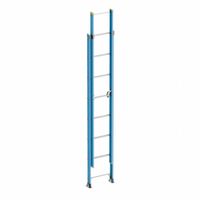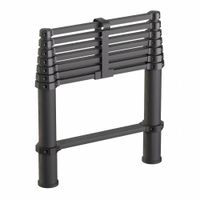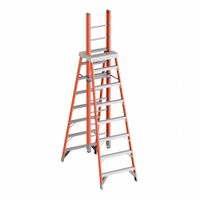Call +(254) 703 030 000 / 751 483 999 / 721 704 777
- Home
- Material Handling
- Ladders Platforms Personnel Lifts
- Ladders
- Extension Telescoping Ladders
.....Read More
Frequently Asked Questions
1. How do you safely use an extension ladder?
1. Inspect the Ladder: Before use, check for any damage, such as cracks, bends, or missing parts. Ensure all moving parts function properly.
2. Choose the Right Ladder: Select a ladder of appropriate length for the task. The ladder should extend at least three feet above the roofline or working surface.
3. Set Up on Stable Ground: Place the ladder on a firm, level surface. Use ladder levelers if necessary to stabilize on uneven ground.
4. Follow the 4-to-1 Rule: Position the base of the ladder one foot away from the wall for every four feet of ladder height to ensure stability.
5. Secure the Ladder: Use ladder stabilizers or tie the top of the ladder to a secure point to prevent slipping or movement.
6. Climb Safely: Always face the ladder when climbing and maintain three points of contact (two hands and one foot or two feet and one hand).
7. Avoid Overreaching: Keep your body centered between the side rails. Move the ladder as needed to avoid leaning too far to the side.
8. Use Proper Footwear: Wear slip-resistant shoes to prevent slipping while climbing.
9. Be Mindful of Weather: Avoid using the ladder in windy or wet conditions, which can increase the risk of slipping or losing balance.
10. Limit Load: Do not exceed the ladder’s weight capacity, including your weight and any tools or materials.
11. Work with a Partner: If possible, have someone hold the base of the ladder for added stability and assistance.
12. Follow Manufacturer’s Instructions: Adhere to all guidelines and warnings provided by the ladder manufacturer for safe use.
By following these steps, you can minimize the risk of accidents and ensure safe use of an extension ladder.
2. What is the difference between an extension ladder and a telescoping ladder?
An extension ladder and a telescoping ladder are both designed to reach high places, but they differ in structure, functionality, and use.
An extension ladder consists of two or more sections that slide apart to extend the ladder's length. It typically requires a stable surface to lean against, such as a wall or tree. The sections are connected by brackets or locks, allowing the ladder to be adjusted to various heights. Extension ladders are often used for tasks like painting, cleaning gutters, or accessing roofs. They are generally made of materials like aluminum, fiberglass, or wood, offering durability and strength. However, they can be bulky and require significant storage space.
A telescoping ladder, on the other hand, is designed with overlapping sections that slide into each other, much like a telescope. This design allows the ladder to be compacted to a fraction of its extended length, making it highly portable and easy to store. Telescoping ladders are typically made of lightweight materials such as aluminum, making them easy to carry. They are ideal for tasks that require frequent transportation or where storage space is limited. The ladder can be extended to various lengths, providing flexibility for different tasks. However, telescoping ladders may not be as stable as extension ladders when fully extended, and they often have lower weight capacities.
In summary, the main differences lie in their design and functionality: extension ladders offer greater stability and are suited for heavy-duty tasks, while telescoping ladders provide portability and convenience for lighter tasks.
3. How do you determine the right size extension ladder for a job?
To determine the right size extension ladder for a job, consider the following factors:
1. **Height of the Work Area**: Measure the height of the area you need to reach. The ladder should extend 3 feet beyond the roofline or working surface for stability and safety.
2. **Ladder Angle**: Position the ladder at a 75-degree angle. For every 4 feet of height you need to climb, the base of the ladder should be 1 foot away from the wall.
3. **Overlap Requirement**: Extension ladders require a certain amount of overlap between sections for stability. Typically, ladders up to 32 feet need a 3-foot overlap, 32-36 feet need a 4-foot overlap, and 36-48 feet need a 5-foot overlap.
4. **Ladder Duty Rating**: Choose a ladder with a duty rating that supports your weight plus any tools or materials. Ratings range from Type III (200 lbs) to Type IAA (375 lbs).
5. **Material**: Consider the ladder material. Aluminum is lightweight and resistant to corrosion, while fiberglass is heavier but non-conductive, making it safer for electrical work.
6. **Environment**: Assess the environment. For uneven or soft ground, consider a ladder with adjustable legs or stabilizers.
7. **Storage and Transport**: Ensure the ladder can be easily stored and transported. Longer ladders may require a larger vehicle or storage space.
By considering these factors, you can select an extension ladder that is safe, effective, and appropriate for your specific job requirements.
4. How do you maintain and store an extension ladder?
To maintain and store an extension ladder properly, follow these steps:
1. **Inspection**: Regularly inspect the ladder for any damage, such as cracks, bends, or corrosion. Check the rungs, rails, and locking mechanisms to ensure they are in good condition.
2. **Cleaning**: Clean the ladder after use, especially if it has been exposed to dirt, chemicals, or moisture. Use a mild detergent and water to remove any debris, and dry it thoroughly to prevent rust or corrosion.
3. **Lubrication**: Apply a light lubricant to the moving parts, such as the pulleys and locks, to ensure smooth operation. Avoid using excessive oil, which can attract dirt.
4. **Storage Location**: Store the ladder in a dry, cool place away from direct sunlight and harsh weather conditions. Prolonged exposure to the elements can weaken the ladder material.
5. **Positioning**: Store the ladder horizontally on racks or hooks to prevent sagging. Ensure it is supported at several points along its length to maintain its shape.
6. **Security**: If storing outdoors, secure the ladder to prevent theft and unauthorized use. Use locks or chains if necessary.
7. **Weight Limit**: Adhere to the ladder's weight limit to prevent damage. Overloading can cause structural failure.
8. **Usage Guidelines**: Follow the manufacturer's guidelines for use and maintenance. This includes proper setup, angle, and extension limits.
9. **Training**: Ensure that anyone using the ladder is trained in its proper use and maintenance to prevent accidents and damage.
10. **Repairs**: Address any repairs immediately. Do not use a damaged ladder until it has been properly repaired or replaced.
By following these steps, you can extend the life of your extension ladder and ensure it remains safe for use.
5. What are the weight limits for extension ladders?
Extension ladders are typically categorized by their duty ratings, which indicate the maximum weight they can safely support. These ratings are established by the American National Standards Institute (ANSI) and Occupational Safety and Health Administration (OSHA) in the United States. The weight limits include the combined weight of the user, their clothing, tools, and any materials being carried. Here are the common duty ratings for extension ladders:
1. **Type III (Light Duty)**: These ladders have a weight limit of 200 pounds. They are suitable for light household tasks and are not recommended for professional or heavy-duty use.
2. **Type II (Medium Duty)**: With a weight limit of 225 pounds, these ladders are designed for medium-duty use, such as painting or light maintenance work. They are often used by homeowners and light commercial users.
3. **Type I (Heavy Duty)**: These ladders can support up to 250 pounds and are intended for heavy-duty use. They are commonly used in construction and industrial settings.
4. **Type IA (Extra Heavy Duty)**: With a weight capacity of 300 pounds, these ladders are designed for extra heavy-duty tasks. They are suitable for professional use, including construction and industrial applications.
5. **Type IAA (Special Duty)**: These ladders have the highest weight limit of 375 pounds. They are used for special duty tasks that require maximum strength and durability, often in professional and industrial environments.
When selecting an extension ladder, it is crucial to consider the total weight it will need to support and choose a ladder with an appropriate duty rating to ensure safety and compliance with regulations.
6. How do you properly extend and lock an extension ladder?
1. **Inspection**: Before using the ladder, inspect it for any damage or defects. Ensure all parts are in good working condition.
2. **Positioning**: Place the ladder on a stable, level surface. Ensure the base is one-quarter of the ladder’s working length away from the wall or structure (4:1 ratio).
3. **Unlocking**: Disengage the rung locks or latches. These are usually located on the sides of the ladder where the fly section meets the base section.
4. **Extending**: With the ladder positioned correctly, extend the fly section by pulling the rope or using the pulley system. Ensure the ladder is extended to the desired height, but do not exceed the maximum length indicated by the manufacturer.
5. **Locking**: Once extended, engage the rung locks or latches to secure the fly section. Ensure they are fully locked into place on the rungs.
6. **Stabilizing**: Check that the ladder is stable. If necessary, use ladder levelers or stabilizers for additional support.
7. **Securing**: If working at height, secure the top of the ladder to the structure using a ladder tie-off or strap to prevent movement.
8. **Climbing**: Maintain three points of contact while climbing. Face the ladder and use both hands to grip the rungs.
9. **Usage**: Do not overreach or lean too far to the side. Keep your body centered between the side rails.
10. **Descending**: When finished, carefully descend the ladder, maintaining three points of contact.
11. **Retracting**: Disengage the rung locks, lower the fly section slowly, and ensure it is fully retracted.
12. **Storage**: Store the ladder in a dry, secure place to prevent damage.
7. What are the safety features to look for in an extension ladder?
When selecting an extension ladder, prioritize the following safety features:
1. **Material Quality**: Choose ladders made from durable materials like aluminum or fiberglass. Fiberglass is non-conductive, making it safer for electrical work.
2. **Weight Capacity**: Ensure the ladder's duty rating matches or exceeds the weight it will support, including the user and any tools or materials.
3. **Locking Mechanisms**: Look for secure locking mechanisms that prevent the ladder from collapsing or extending unintentionally. Locks should be easy to engage and disengage.
4. **Non-Slip Rungs**: Rungs should have a non-slip surface to prevent slipping, even in wet conditions. D-shaped rungs offer better foot support.
5. **Stabilizers and Levelers**: Consider ladders with stabilizers or levelers to provide additional stability on uneven surfaces.
6. **Rope and Pulley System**: A smooth-operating rope and pulley system allows for easy extension and retraction of the ladder.
7. **Base and Feet Design**: The base should be wide for stability, and the feet should have non-slip, non-marring pads to prevent movement and protect surfaces.
8. **Height and Reach**: Ensure the ladder is tall enough for the intended tasks, considering the overlap required for stability when extended.
9. **Safety Labels and Instructions**: Check for clear safety labels and instructions for proper use and maintenance.
10. **ANSI and OSHA Compliance**: Verify that the ladder meets ANSI (American National Standards Institute) and OSHA (Occupational Safety and Health Administration) standards for safety.
11. **Weather Resistance**: For outdoor use, ensure the ladder is resistant to weather conditions, such as rust or UV damage.
12. **Portability Features**: Consider features like wheels or handles for easier transport and storage.
By focusing on these safety features, you can select an extension ladder that minimizes risks and enhances safety during use.


